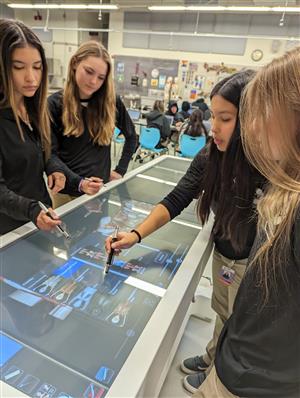- MetroED
- Homepage
Sports Medicine and Kinesiology program receives state-of-the-art Anatomage Table

Maggie Kasberger can now teach lessons about life from the dead through a new Anatomage Table in her Sports and Medicine Kinesiology program with Silicon Valley Career Technical Education (SVCTE).
The touch-screen equipment provides a realistic life-sized 3D anatomy system as if the students were working with an actual cadaver and allows them to conduct virtual dissections on images of real-life bodies that were donated for science. They also can view a beating heart, explore the impact of various diseases or injuries, and drill down to closely study each system of the human body.
The table can lay horizontally and also be propped up and put onto the screen to allow all students to see it at the same time from their desks. Additionally, they can answer questions on their iPads and submit them to Kasberger.
“I am beyond ecstatic about the table,” she said.
Even before the equipment was received, Kasberger said nearby college institutions raved about the program in place for students.
“What they are now getting to learn supersedes anything that you can find in an anatomy lab in the Bay Area,” she said. “I’ve brought in Foothill College and San Jose State University to look at what our curriculum provides and they both informed me this class has more information than any of their classes combined for a bachelor’s degree, which is super cool.”
So this equipment will undoubtedly have a monumental impact on increasing student engagement and learning.
“This is the kinesthetic learning that has been lacking from the classroom because you can’t find case studies like this for legal purposes,” Kasberger said. “You can’t Google and find this. And even if you can, you can’t spin it around and touch it.”
Kasberger’s students first began using the table on December 5, and five of them worked in a group to learn more about the joint assignments of different locations, movement, and degrees of freedom.
“It’s very helpful,” said Yael Shpits from Milpitas High School in Milpitas Unified School District.
Viviana Gonzales from Oak Grove High School in East Side Union High School District shared that she enjoyed how the table can start with the actual image of the human and go layer by layer, whittling away to a view of the muscles and eventually even further for the skeletal observation. She also enjoyed the case studies of different real injuries.
Kasberger is happy to see how the real-life lessons will be transformed for her students.
“I can teach them from the textbook until I am blue in the face,” she said. “I can say you have a comminuted fracture of the femur and then they can ask how it happened and what it looks like. I can explain it, I can draw it up on the board. You cannot draw on the board this right here.”
Kasberger is also the Health Occupations Students of America (HOSA) lead adviser, so when she saw this equipment at its state competition last year, she knew she wanted it to enhance learning in her program. She started the grant application process last spring and the table was installed on December 1.

